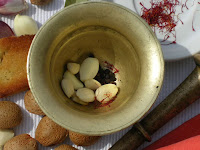 I have a delightful new cookbook, MEDITERRANEAN CLAY POT COOKING, by Paula Wolfert. Paula is friend, mentor and inspiration. She and I share a love for Mediterranean flavors and I am honored that she credits me in her book with a version of the Spanish tapas dish, Sizzling Shrimp with Garlic and Hot Pepper. She writes that she first prepared the shrimp for a party back in the late 1950s, attended by, amongst others, poet Allen Ginsberg and novelist Jack Kerouac. Kerouac, who enjoyed the shrimp, told Paula: “You’ve got great legs.”
I have a delightful new cookbook, MEDITERRANEAN CLAY POT COOKING, by Paula Wolfert. Paula is friend, mentor and inspiration. She and I share a love for Mediterranean flavors and I am honored that she credits me in her book with a version of the Spanish tapas dish, Sizzling Shrimp with Garlic and Hot Pepper. She writes that she first prepared the shrimp for a party back in the late 1950s, attended by, amongst others, poet Allen Ginsberg and novelist Jack Kerouac. Kerouac, who enjoyed the shrimp, told Paula: “You’ve got great legs.” Paula’s book includes recipes from all round the Mediterranean (I’m trying out some of the Turkish dishes). She gives a good description of various types of earthenware pots, crocks, casseroles, daubières, cazuelas and tagines.
Cazuelas are Spain’s contribution to clay pot cooking. They are wide, flat casseroles of low-fired clay, glazed on the inside, so liquids don’t escape through the porous clay, and unglazed on the bottom. Cazuelas come in many sizes, though they generally are not very deep. Rarely do they come with lids.
I use my cazuelas directly on a gas stove burner. I don’t have any experience with electric or ceramic cooktops, so I suggest you follow Paula’s advice and always use a heat diffuser when cooking in earthenware on these types of stovetops.
You can use a cazuela in place of a skillet, a paella pan (a paella becomes “rice cazuela”), a sauté pan, an oven casserole. Earthenware holds a slow, steady heat, allowing foods to cook gently and evenly. Earthenware holds the heat, so food continues to cook even after you remove it from the stove. You can even sauté and brown foods in a cazuela—add enough oil to cover the bottom surface and heat the oil until very hot. Don’t crowd the pan with the foods to be browned.
New cazuelas taste of raw clay. Soak them in water for 24 hours. Dry well, then coat the inside with olive oil and place in a medium-low oven for 40 minutes. Frequent use is the best method for seasoning cazuelas.
Never heat an empty cazuela. Take care not to set a hot one down on a cold surface, as it might crack. Really big cazuelas are heavy and not easy to manoeuvre in and out of the oven. Small cazuelitas are fine for microwave cooking and reheating.
Here in Spain, cazuela is both the name of the cooking vessel and of foods cooked in it. Most cazuela dishes start with a sauté, or sofrito, and finish braising with liquid.
My recipe for monkfish, clams and potatoes in almond sauce is a good example of cazuela cookery. The almonds both flavor and thicken the sauce. Monkfish is a sweet-fleshed, toothsome fish, easy to fillet, as it has no small bones. If you can get the whole fish, use the head to prepare a simple fish stock, which will add flavor to the finished dish. I cooked this recipe (as pictured below) in a 30-cm/ 12-in cazuela.
Cazuela de Rape y Patatas
Monkfish and Potatoes in Cazuela
Serves 4.
 3 tablespoons olive oil
3 tablespoons olive oil1 slice bread, crusts removed
3 cloves garlic
25 almonds, blanched and skinned
½ cup chopped green pepper
½ cup chopped onion
½ cup chopped tomato
½ cup white wine
Pinch of crushed saffron
½ teaspoon pimentón (paprika)
1 pound potatoes, peeled and cut in chunks
1 teaspoon salt
1 cup fish stock
1 pound boneless monkfish, cut in chunks
1 pound scrubbed clams
chopped parsley
Heat the oil in an earthenware cazuela. Fry the bread, garlic and almonds until golden. Skim out. Add the green pepper and onion to the cazuela and cook on medium heat until onion is softened, 10 minutes. Add the tomato and continue frying. Add the potatoes.
Combine the bread, garlic, almonds, wine, saffron and pimentón in a blender (or crush in a mortar). Blend to make a smooth sauce. Pour the sauce over the potatoes. Add salt and fish stock. Cook on a medium heat, stirring occasionally, until potatoes are tender, about 20 minutes. Add more stock or water if necessary to keep the sauce from scorching.
Turn up the heat and add the chunks of monkfish and clams. Cook, stirring occasionally, until fish is cooked and the clam shells open, about 10 minutes. Sprinkle with chopped parsley and serve.











